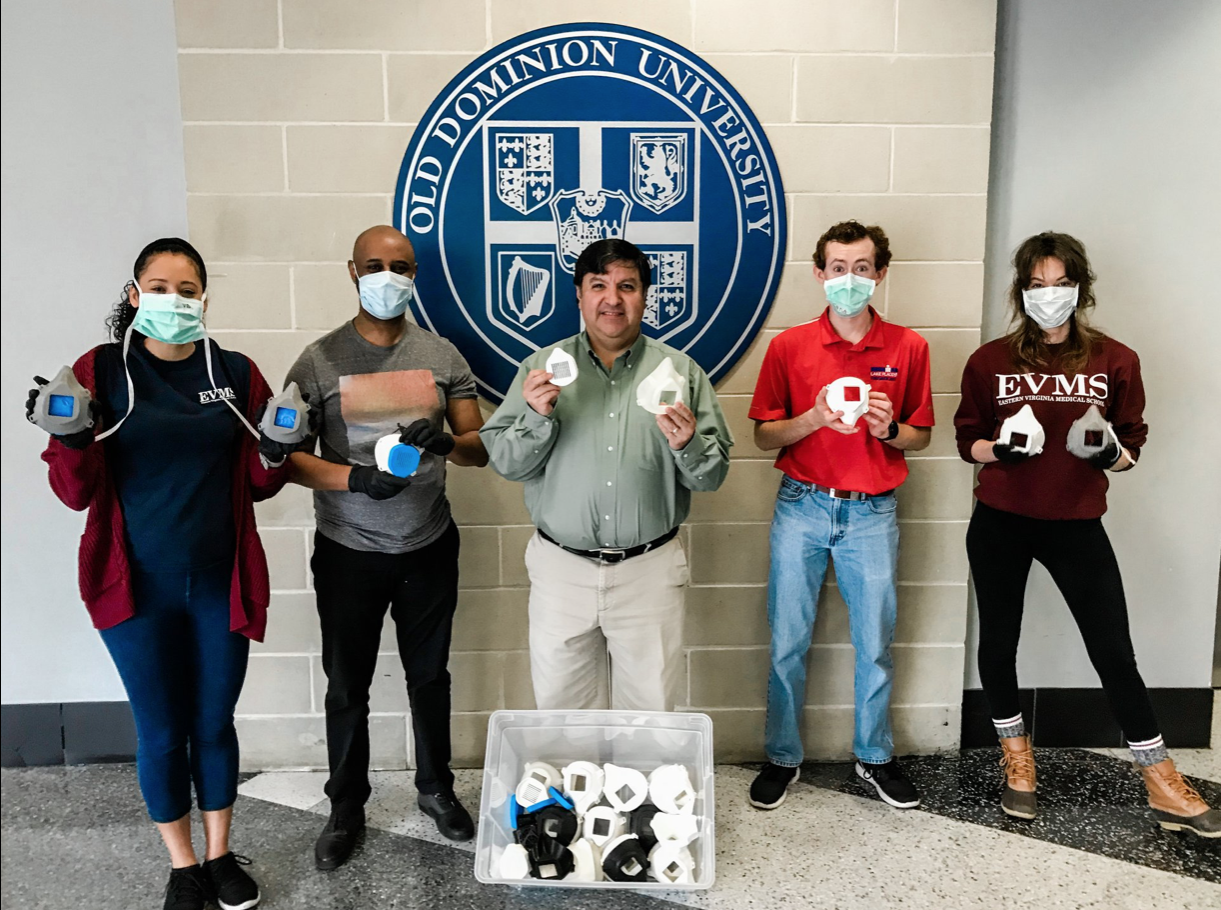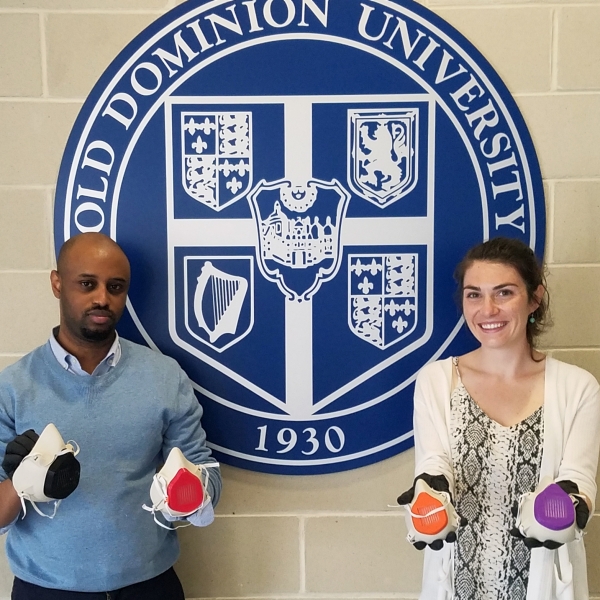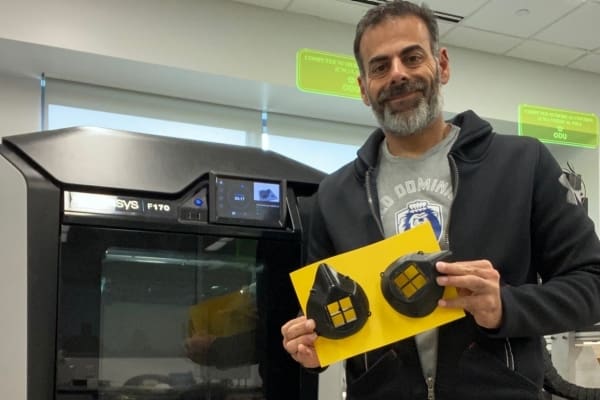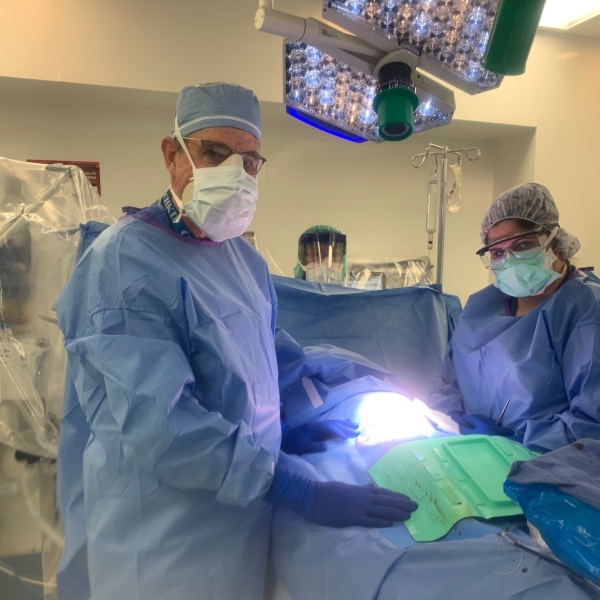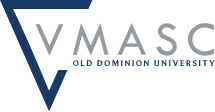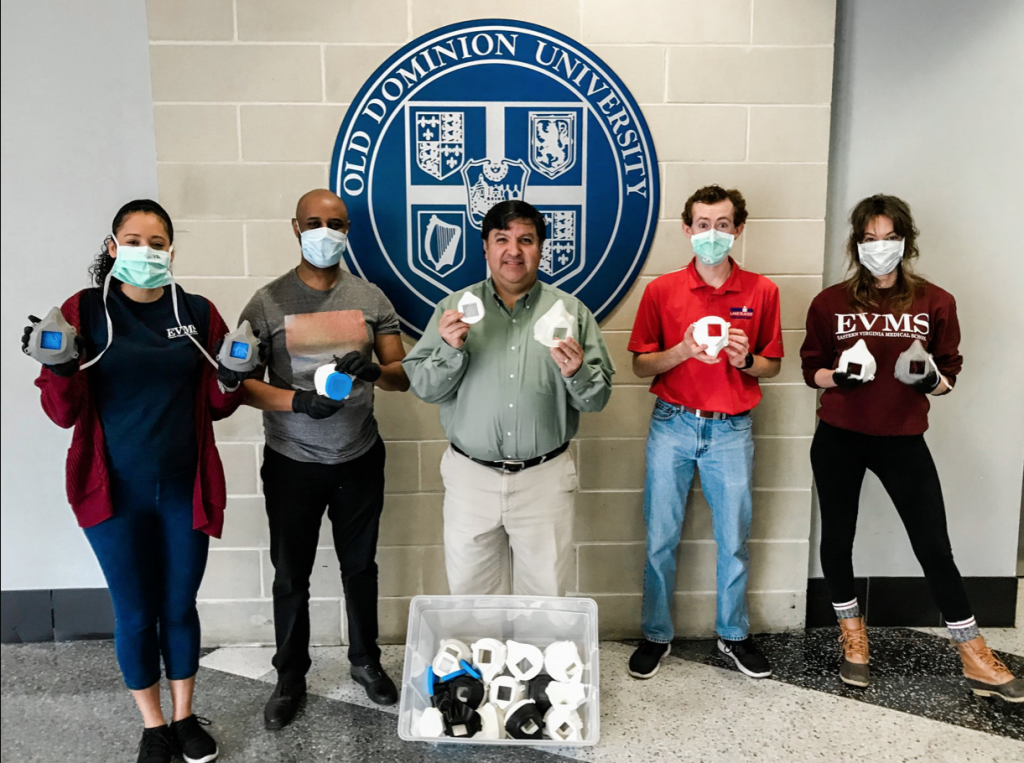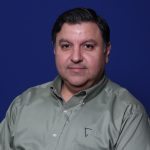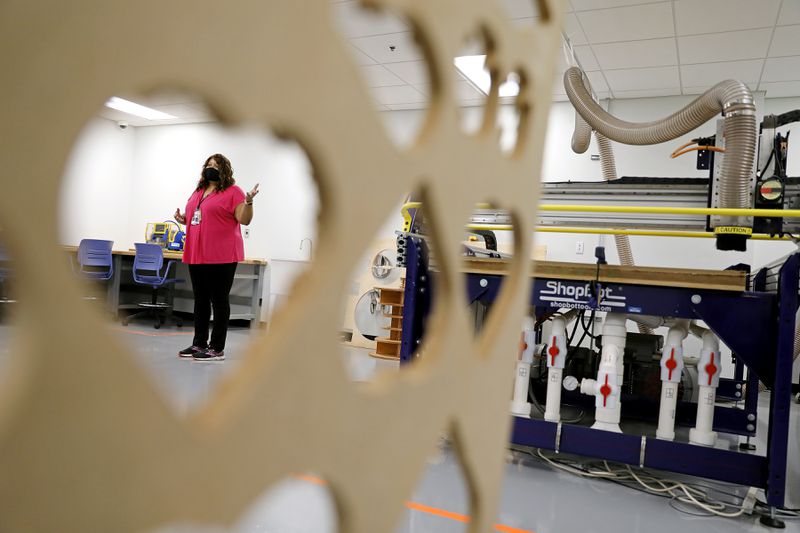
Hampton Roads students explore coding, music production, entrepreneurship in new program
April 5, 2021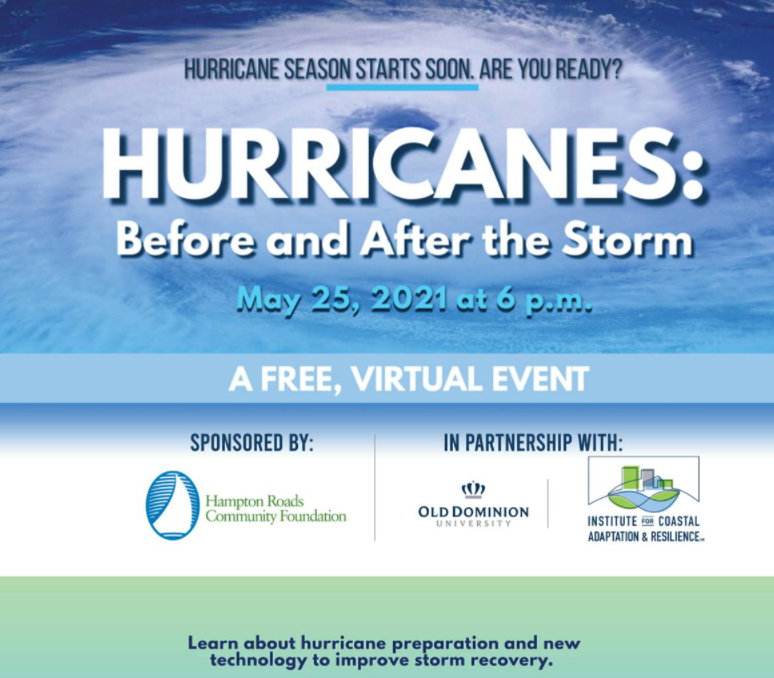
ODU, Hampton Roads Community Foundation preparing residents for hurricanes through virtual event
May 20, 2021
Hampton Roads students explore coding, music production, entrepreneurship in new program
April 5, 2021
ODU, Hampton Roads Community Foundation preparing residents for hurricanes through virtual event
May 20, 2021ODU Faculty and Students Answer the Call for PPE
Written by Keith Pierce
April 3, 2020
Across the country, health-care workers treating COVID-19 patients face a critical shortage of personal protection equipment. In response to the increasing demand, Old Dominion University President John R. Broderick was quick to offer much-needed support to local hospitals. Soon after, students and faculty across campus were putting their expertise to use by creating 3D-printed personal protective equipment.
Dr. Jordan Asher, Sentara's senior vice president and chief physician executive, called Ben Stuart, interim dean of the Batten College of Engineering and Technology at ODU, asking for help printing medical parts. Stuart enlisted the expertise of Sebastian Bawab, professor and chair, Department of Mechanical and Aerospace Engineering and Tony Dean, associate professor and assistant dean for research in the College.
"I have a tremendous amount of confidence in our engineers," Stuart said. "I knew when they got the word, they would jump at the opportunity to put their expertise to work for this important cause."
Bawab and Dean went to work in the new Advanced Manufacturing Lab that Dean helped establish. The lab is equipped with several industrial 3D printers that print a wide variety of materials.
Justin Seemueller, a respiratory clinical specialist with Sentara, was asked to collaborate with the ODU team.
"Within a few hours, I was dropping off parts to Tony Dean," Seemueller said.
Seemueller's idea was to combine a positive pressure face mask, normally used by patients, with a viral filter to turn them into a reusable protective mask capable of being sterilized easily.
"I asked Tony and the ODU team to make adapters for two main types; one that would double serve as a face shield, and another that would work for people who wear glasses," he said.
Enlisting the help of engineering students Juan Cortez, Chris Betton and Dante Lege, Dean and Bawab went to work on the prototype.
"Taking the parts Sentara sent us, we had to use a process called reverse engineering," Dean explained.
"That means carefully measuring and remodeling the parts on a computer, modifying the design to account for the material type and process of 3D printing to get a functioning design that is further tested," Bawab added.
Within hours, Seemueller received a prototype hand-delivered by Dean.
"We have all been extremely appreciative of the work and expertise offered by ODU," said Seemueller, who has tested each mask made with the 3D-printed adapters. "They even agreed to share the final design file and instructions so we can reach out to other 3D printing facilities to ramp up production."
Another engineer, Rick McKenzie, professor and chair of computational modeling and simulation engineering, has developed an open-source mask designed with a removable filter for health-care providers at the Children's Hospital of The King's Daughters (CHKD). After a discussion about various designs with Associate Dean Rafael Landaeta, Orlando Ayala, associate professor of engineering technology, and students from the ODU Engineering Makerspace and Invention Center, McKenzie's team began 3D printing the masks.
"We printed several promising shapes from the internet and worked with CHKD to settle on a shape that we were able to combine with weatherproofing material as well as methods to seal the 3D printer material so that it could be airtight," McKenzie said. "The result is a comfortable mask intended to be used when N95s run out and can be reused by disinfecting with hydrogen peroxide."
"We have a wonderful partnership with the engineering department," said Dr. Robert Kelly, chief of surgery at CHKD. "We've collaborated with them on several projects that have strengthened our abilities to measure treatment progress with our chest-wall deformity patients. We know their work is top-notch and weren't at all surprised by how impressed others were here at CHKD by the prototype ODU brought us."
With the help of Hector Garcia, senior project scientist at the Virginia Modeling, Analysis, and Simulation Center (VMASC); Nahom Kidane, ODU computational modeling and simulation graduate student; as well as University of Miami medical student, Kathleen Kelly, (the daughter of Dr. Robert Kelly who is home due to COVID-19), McKenzie hopes to print up to 100 masks. Medical student volunteers from Eastern Virginia Medical School (EVMS) also helped in the effort.
"To say we're grateful is an understatement," Dr. Kelly said. "Once again, ODU has come through for our local community in a time of great need,"
For Petros Katsioloudis, professor and chair of STEM education and professional studies, the need to address the challenge of providing protective equipment for providers hit close to home.
"Having a wife who is a nurse, this battle became more personal," he said. "I want her to stay healthy for her own sake but to also help others."
Using a mask designed by a Billings Clinic in Montana, Katsioloudis began 3D printing a mask for his wife but immediately saw an important opportunity to contribute to the greater need.
"During these challenging times it is important that we all help," he said. "3D printing is mainly intended for prototype and modeling. It's a slow process as it takes about two hours to 3D print one mask. However, other industrial processes will allow a lot faster production, so I am now working with my colleague Basim Matrood (a lecturer in STEM education and professional studies) to implement those."
Brittany Samulski, an assistant professor in the doctor of physical therapy program in the School of Rehabilitation Sciences at ODU, also answered the call when she recognized that health-care providers were short on protective equipment.
Samulski and her husband, Chris Samulski, who is director of business intelligence and analytics at Arbela Technologies, Inc., an Irvine, Calif.-based software company, have been using their 3D printer to produce face shields for local health-care workers from their home - and donate them free of charge.
"We both work from home now, so we start a print and go in to restart it every three hours," Brittany said. "We managed to print 20 face shields on the first day of full production."
The couple's concept has caught fire. They organized a group of local makers through Facebook contacts and have 10 3D printers running.
Connections:
ODU Faculty and Students Answer the Call for PPE
Written by Keith Pierce
April 3, 2020
Across the country, health-care workers treating COVID-19 patients face a critical shortage of personal protection equipment. In response to the increasing demand, Old Dominion University President John R. Broderick was quick to offer much-needed support to local hospitals. Soon after, students and faculty across campus were putting their expertise to use by creating 3D-printed personal protective equipment.
Dr. Jordan Asher, Sentara's senior vice president and chief physician executive, called Ben Stuart, interim dean of the Batten College of Engineering and Technology at ODU, asking for help printing medical parts. Stuart enlisted the expertise of Sebastian Bawab, professor and chair, Department of Mechanical and Aerospace Engineering and Tony Dean, associate professor and assistant dean for research in the College.
"I have a tremendous amount of confidence in our engineers," Stuart said. "I knew when they got the word, they would jump at the opportunity to put their expertise to work for this important cause."
Bawab and Dean went to work in the new Advanced Manufacturing Lab that Dean helped establish. The lab is equipped with several industrial 3D printers that print a wide variety of materials.
Justin Seemueller, a respiratory clinical specialist with Sentara, was asked to collaborate with the ODU team.
"Within a few hours, I was dropping off parts to Tony Dean," Seemueller said.
Seemueller's idea was to combine a positive pressure face mask, normally used by patients, with a viral filter to turn them into a reusable protective mask capable of being sterilized easily.
"I asked Tony and the ODU team to make adapters for two main types; one that would double serve as a face shield, and another that would work for people who wear glasses," he said.
Enlisting the help of engineering students Juan Cortez, Chris Betton and Dante Lege, Dean and Bawab went to work on the prototype.
"Taking the parts Sentara sent us, we had to use a process called reverse engineering," Dean explained.
"That means carefully measuring and remodeling the parts on a computer, modifying the design to account for the material type and process of 3D printing to get a functioning design that is further tested," Bawab added.
Within hours, Seemueller received a prototype hand-delivered by Dean.
"We have all been extremely appreciative of the work and expertise offered by ODU," said Seemueller, who has tested each mask made with the 3D-printed adapters. "They even agreed to share the final design file and instructions so we can reach out to other 3D printing facilities to ramp up production."
Another engineer, Rick McKenzie, professor and chair of computational modeling and simulation engineering, has developed an open-source mask designed with a removable filter for health-care providers at the Children's Hospital of The King's Daughters (CHKD). After a discussion about various designs with Associate Dean Rafael Landaeta, Orlando Ayala, associate professor of engineering technology, and students from the ODU Engineering Makerspace and Invention Center, McKenzie's team began 3D printing the masks.
"We printed several promising shapes from the internet and worked with CHKD to settle on a shape that we were able to combine with weatherproofing material as well as methods to seal the 3D printer material so that it could be airtight," McKenzie said. "The result is a comfortable mask intended to be used when N95s run out and can be reused by disinfecting with hydrogen peroxide."
"We have a wonderful partnership with the engineering department," said Dr. Robert Kelly, chief of surgery at CHKD. "We've collaborated with them on several projects that have strengthened our abilities to measure treatment progress with our chest-wall deformity patients. We know their work is top-notch and weren't at all surprised by how impressed others were here at CHKD by the prototype ODU brought us."
With the help of Hector Garcia, senior project scientist at the Virginia Modeling, Analysis, and Simulation Center (VMASC); Nahom Kidane, ODU computational modeling and simulation graduate student; as well as University of Miami medical student, Kathleen Kelly, (the daughter of Dr. Robert Kelly who is home due to COVID-19), McKenzie hopes to print up to 100 masks. Medical student volunteers from Eastern Virginia Medical School (EVMS) also helped in the effort.
"To say we're grateful is an understatement," Dr. Kelly said. "Once again, ODU has come through for our local community in a time of great need,"
For Petros Katsioloudis, professor and chair of STEM education and professional studies, the need to address the challenge of providing protective equipment for providers hit close to home.
"Having a wife who is a nurse, this battle became more personal," he said. "I want her to stay healthy for her own sake but to also help others."
Using a mask designed by a Billings Clinic in Montana, Katsioloudis began 3D printing a mask for his wife but immediately saw an important opportunity to contribute to the greater need.
"During these challenging times it is important that we all help," he said. "3D printing is mainly intended for prototype and modeling. It's a slow process as it takes about two hours to 3D print one mask. However, other industrial processes will allow a lot faster production, so I am now working with my colleague Basim Matrood (a lecturer in STEM education and professional studies) to implement those."
Brittany Samulski, an assistant professor in the doctor of physical therapy program in the School of Rehabilitation Sciences at ODU, also answered the call when she recognized that health-care providers were short on protective equipment.
Samulski and her husband, Chris Samulski, who is director of business intelligence and analytics at Arbela Technologies, Inc., an Irvine, Calif.-based software company, have been using their 3D printer to produce face shields for local health-care workers from their home - and donate them free of charge.
"We both work from home now, so we start a print and go in to restart it every three hours," Brittany said. "We managed to print 20 face shields on the first day of full production."
The couple's concept has caught fire. They organized a group of local makers through Facebook contacts and have 10 3D printers running.
